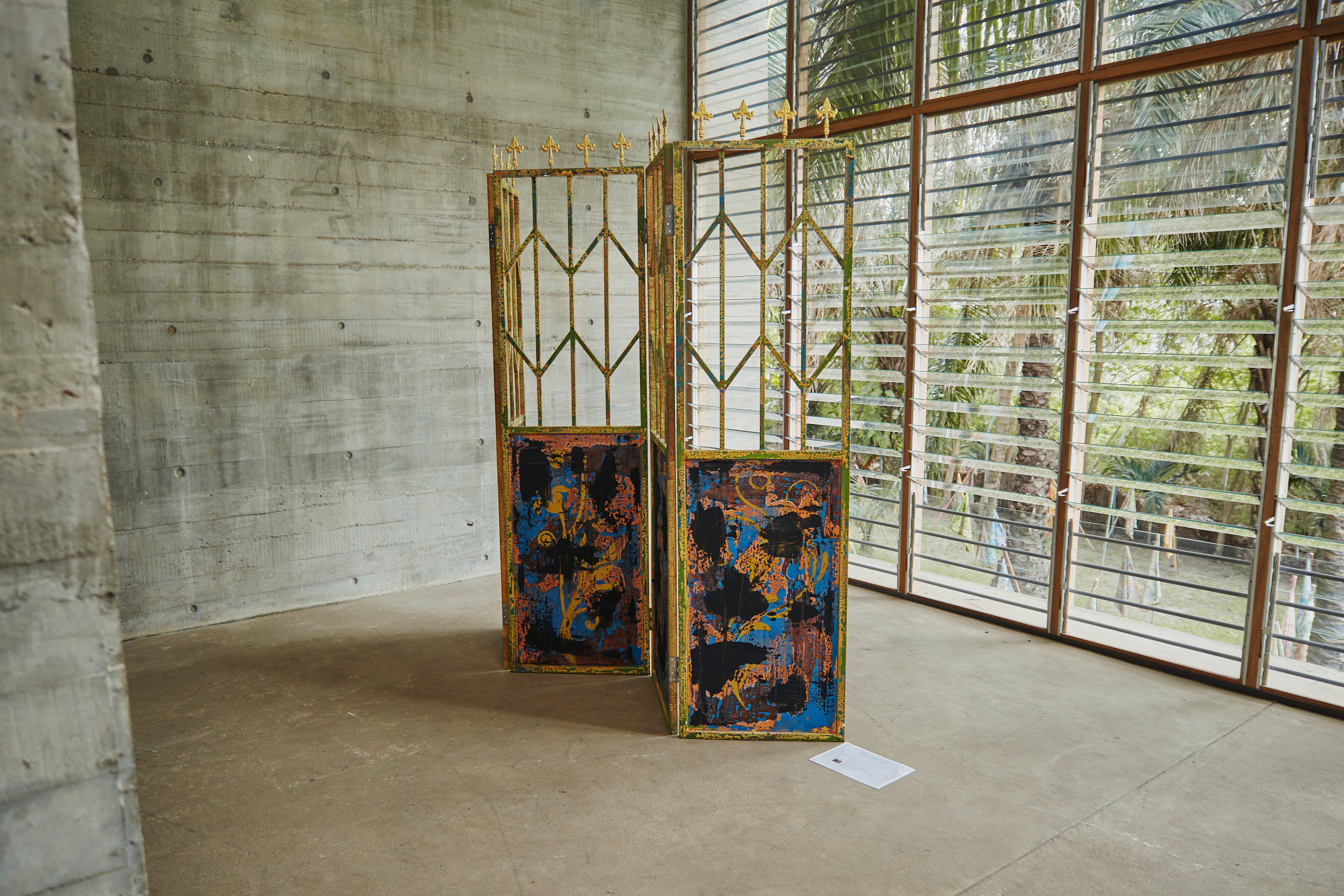Al Hassan Issah: Seduced By Charms of A Mistake
Al Hassan Issah’s works extend the idea of painting. They interrogate paintings beyond their pictureness and flatness. Using painting as an entry point, the works extend and collapse into the realms of design, sculpture, architecture, metalmaking and the like. What could painting be? What is the potential of painting to both redeem its blind spots and to expand on its vision? How could painting engineer other things? For example, how could painting create space as opposed to occupying space? What could painting do in directing encounters and theatricality?
The title of the present show is an allusion to Late Night Jazz’s 2019 music off the 1,000 Choices Can't Be Wrong album. Among other things, two points stand out. The electronic beat seems like a collage of soundscape taken from different spaces. It feels as though you might have encountered strands of the sound somewhere. In the background, the emerging sound is like something is being cut with an industrial machine. It flashes and vanishes. Then almost 3 minutes into the music, the background and foreground merge and a flute-like sound starts and files the listener out of the piece.
The title of the present show is an allusion to Late Night Jazz’s 2019 music off the 1,000 Choices Can't Be Wrong album. Among other things, two points stand out. The electronic beat seems like a collage of soundscape taken from different spaces. It feels as though you might have encountered strands of the sound somewhere. In the background, the emerging sound is like something is being cut with an industrial machine. It flashes and vanishes. Then almost 3 minutes into the music, the background and foreground merge and a flute-like sound starts and files the listener out of the piece.


Space is something that Issah as an artist is keenly interested in and studies actively. Using Kumase, the Asante regional capital, and other urban spaces, the artist makes sketches and photographs of what he will ordinarily do and see.

This is where the artist’s interests in material cultures unfold. He finds inspiration in colours and forms in the city’s object culture such as finishings of metal pots (that sit on top of makeshift kiosks), looming gate grills, burglar bars, billboard signages, windows and flags. From his immediate living environment, he finds uses in henna and posters.
If we are to believe Marxist spatial theorists, cities, as spatial entities, are both symptoms and producers of social relations. Writing as an introduction to his book Oxford Street, Accra: City Life and the Itineraries of Transnationalism, Professor Ato Quayson asserts that space is an organising principle. Taking the two together, we are led to ask: what are the social relations and organisation, and historical antecedents that produce the object culture that the artist is interested in?
In 1817, British writer Thomas Edward Bowdich traveled to Kumasi to negotiate a peace treaty on behalf of the African Company of Merchants. A year later, he published a book in which he said that there were nine entries/exits to and from Kumasi. Out of the nine roads, four led towards the north of Kumasi. At the apex of its imperial power, Kumase became a cosmopolitan space with a heterogenous ethnic composition.
If we are to believe Marxist spatial theorists, cities, as spatial entities, are both symptoms and producers of social relations. Writing as an introduction to his book Oxford Street, Accra: City Life and the Itineraries of Transnationalism, Professor Ato Quayson asserts that space is an organising principle. Taking the two together, we are led to ask: what are the social relations and organisation, and historical antecedents that produce the object culture that the artist is interested in?
In 1817, British writer Thomas Edward Bowdich traveled to Kumasi to negotiate a peace treaty on behalf of the African Company of Merchants. A year later, he published a book in which he said that there were nine entries/exits to and from Kumasi. Out of the nine roads, four led towards the north of Kumasi. At the apex of its imperial power, Kumase became a cosmopolitan space with a heterogenous ethnic composition.


Issah uses layering techniques to sometimes achieve what he has observed including using oil-water emulsion and acrylic. With the layering, he makes a formalist intervention in the foreground/background dichotomy in Eurocentric painting canon. In the best part of his peeling and rusting effects, it is hard to tell what the backgrounds and foregrounds are.


Be it Baroque, Rococo, Islamic geometric or Kumasi influenced forms, we see how shapes, patterns, and colour guide Issah’s works. In tribute to the Kumasi fabricators, Issah’s works in the main Nubuke Foundation gallery are mounted as you would find them in the fabricator shop. They lean or stand in front of the concrete walls. Outside the gallery, flags stand in the field.
In the end, what this show instigates is encounters. The works, as Kumasi inspired, come in contact with Accra, another cosmopolitan metropolis and continue the tradition of mixing. That brings us to the second take away from the music – the idea of mistake. Or what Issah has referred to as failure. Perhaps, that is what we all are seduced by: the mixing, transplanting, abstraction, extraction and the transgression of ideas – the making of something new, something that pushes us to reconsider our relationship with the built environment.
Kwabena Agyare Yeboah
In the end, what this show instigates is encounters. The works, as Kumasi inspired, come in contact with Accra, another cosmopolitan metropolis and continue the tradition of mixing. That brings us to the second take away from the music – the idea of mistake. Or what Issah has referred to as failure. Perhaps, that is what we all are seduced by: the mixing, transplanting, abstraction, extraction and the transgression of ideas – the making of something new, something that pushes us to reconsider our relationship with the built environment.
Kwabena Agyare Yeboah



